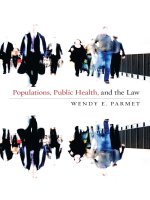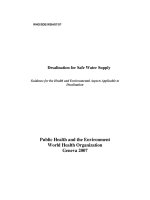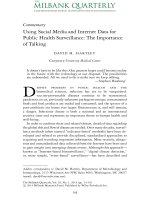georgetown university press populations public health and the law jun 2009
Bạn đang xem bản rút gọn của tài liệu. Xem và tải ngay bản đầy đủ của tài liệu tại đây (1010 KB, 305 trang )
populations, public health, and the law
POPULATIONS,
PUBLIC HEALTH,
and the LAW
WENDY E. PARMET
Georgetown University Press
Washington, D.C.
Georgetown University Press, Washington, D.C. www.press.georgetown.edu
᭧ 2009 by Georgetown University Press. All rights reserved. No part of this book
may be reproduced or utilized in any form or by any means, electronic or
mechanical, including photocopying and recording, or by any information storage
and retrieval system, without permission in writing from the publisher.
Library of Congress Cataloging-in-Publication Data
Parmet, Wendy E
Populations, public health, and the law / Wendy E. Parmet.
p. ; cm.
Includes bibliographical references and index.
ISBN 978–1-58901–261–5 (pbk. : alk. paper)
1. Public health laws—United States. I. Title.
[DNLM: 1. Public Health—legislation & jurisprudence—United States.
2. Delivery of Health Care—legislation & jurisprudence—United States.
3. Health Policy—legislation & jurisprudence—United States. 4. Health
Status—United States. 5. Population—United States.
WA 33 AA1 P254p 2008]
KF3775.P35 2008
344.73’04—dc22
2008034759
⅜ϱ This book is printed on acid-free paper meeting the requirements of the
American National Standard for Permanence in Paper for Printed Library
Materials.
15141312111009 98765432
First printing
Printed in the United States of America
To Herbert and Joan Parmet
CONTENTS
Acknowledgments ix
Abbreviations and Acronyms xi
Introduction 1
1
Public Health and the Population Perspective 5
2
Public Health and American Law 28
3
Toward a Population-Based Legal Analysis: The Supreme
Beef Case 51
4
Population Health and Federalism: Whose Job Is It? 78
5
Individual Rights, Population Health, and Due Process 109
6
A Right to Die? Further Reflections on Due Process Rights 141
7
The First Amendment and the Obesity Epidemic 166
8
A Population-Based Health Law 191
9
Tort Law: A Population Approach to Private Law 219
10
Globalizing Population-Based Legal Analysis 244
11
The Future of Population-Based Legal Analysis 267
Table of U.S. Cases 277
Index 283
vii
AC KN OWLE D GME N TS
M
anypeoplehavehelpedmake this book possible. I especially
want to thank George J. and Kathleen Waters Matthews, whose
support for scholarship at Northeastern University has made
this book possible. I also want to thank my dean, Emily Spieler, for gener-
ous research support and a schedule conducive to writing. Many thanks
are also owed to my wonderful colleagues at Northeastern University
School of Law. In particular, I am grateful to Roger Abrams for insisting
that I finally write the book, to Hope Lewis for showing me the connections
between population-based legal analysis and human rights, and to Mary
O’Connell for always providing encouragement and an open door.
Over the years I have had the great honor to work with and learn from
many eminent scholars in public health and law. Among those with whom
I have collaborated on projects that have informed this book are George
Annas, Christopher Banthin, Richard Daynard, Richard Goodman, Patricia
Illingworth, Peter Jacobson, Wendy Mariner, Anthony Robbins, and Jason
Smith. Without their inspiration and insight this book could not have been
written. I am also very grateful to those who have read all or part of the
various drafts of the manuscript: Patricia Illingworth, Peter Jacobson, Hope
Lewis, Wendy Mariner, Mary O’Connell, and Jason Smith. Any errors and
misunderstandings in this work are my own and do not reflect on my
collaborators and reviewers.
As always, Jan McNew provided unsurpassed secretarial support. The
reference librarians at Northeastern University School of Law, especially
Susan Zago and Kyle Courtney, helped me track down both readily acces-
sible and obscure materials. Many students and former students at North-
eastern University School of Law assisted me with research. Among them
are Robin Ackerman, Tanya Booth, Marc Catalono, Julie Ciollo, Jeremy
Cohen, Lisa Conley, Erik Heath, Dara Hefler, Sarah Klosner, Matthew
McHugh, Siddhartha Mukherjee, Dan Perlman, Audrey Perlow, Golda
ix
x acknowledgments
Philip, Kerry Tipper, Deborah Thorpe, Elena Vizvary, and Erin Wells. I
regret if I have overlooked any of my fine student researchers.
Throughout this project Richard Brown, director of Georgetown Uni-
versity Press, provided wonderful advice and extraordinary encourage-
ment. I had heard that real editors no longer exist; people who say that
have not had the good fortune to meet him.
Finally, I want to thank my family, whose love and patience have made
this work possible. My parents, Joan and Herbert Parmet, nurtured my
appetite for scholarship and set an example that I can only strive to meet.
My husband, Ron Lanoue, has always been there with love and encourage-
ment, through good times and bad. My wonderful children, Daniel and
Anna Lanoue, not only support Mom’s work, they also remind me why
the issues I write about matter.
ABBREVIATIONS AND ACRONYMS
ADA Americans with Disabilities Act
AIDS acquired immunodeficiency syndrome
BMI body mass index
BSE bovine spongiform encephalopathy, aka mad cow disease
CDC Centers for Disease Control and Prevention
CON Certificate of Need
DES diethylstilbestrol
DRG diagnostically related group
EU European Union
EMTALA Emergency Medical Treatment and Active Labor Act
EPA Environmental Protection Agency
FDA Food and Drug Administration
FSIS Food Safety and Inspection Services
GAO Government Accountability Office
GATT General Agreement on Tariffs and Trade
GDP gross domestic product
HAACP Hazard Analysis and Critical Control Point Regulations
HIV human immunodeficiency virus
ICCPR International Covenant on Civil and Political Rights
ICESCR International Covenant on Economic, Social and Cultural
Rights
IFCTC International Framework Convention on Tobacco Control
IHR International Health Regulations
IOM Institute of Medicine
IQA Information Quality Act
MRSA Methicillan-resistant staphylococcus aureus
MSA Master Settlement Agreement
MSEHPA Model State Emergency Health Powers Act
NAFTA North Atlantic Free Trade Agreement
xi
xii abbreviations and acronyms
OED Oxford English Dictionary
PHLA Public Health Law Association
PHLP Public Health Law Program
QALY quality-adjusted life years
SARS severe acute respiratory syndrome
TRIPS Agreement on Trade-Related Aspects of Intellectual
Property Rights
UDHR Universal Declaration of Human Rights
USDA United States Department of Agriculture
WHO World Health Organization
WTO World Trade Organization
XDR-TB extensively drug-resistant tuberculosis
INTRODUCTION
Salus populi suprema lex.
—Common law maxim
T
he venerabl e common law maxim, salus populi suprema lex,
expresses a principle long noted, even if infrequently followed, by
American law: the well-being of the community is the highest law.
The maxim reminds us that law exists, at least in part, to serve the common
good. To do so, law must be understood in light of that goal.
But what is the common good? In a diverse and complex society, such
as our own, people disagree, often vehemently, about what constitutes the
common good. Some citizens equate it with national wealth, others with
military strength; some with godliness, others with secular tolerance.
These disagreements rightly form the spark for public discussion and
democratic engagement. In a democracy, even as imperfect a democracy
as our own, conceptions of the common good are always subject to debate.
Still, there can be little doubt that public health is an important compo-
nent of the common good. When a plague ravages a community, no other
good can be realized until public health is restored. Even when the threat
to public health is not catastrophic, when a society’s survival is not on the
line, the protection of public health remains vital to ensuring that individ-
uals and communities are healthy enough to participate in civic life and
pursue their own life’s goals.
1
Perhaps it is for this reason that the American polity has always pre-
sumed that public health protection is both an appropriate and an impor-
tant goal, if not duty, of government. Indeed, whenever a new threat to
public health appears or gains public salience, be it toxic chemicals or pan-
demic influenza, mad cow disease or autism, the public has always
1
2 introduction
demanded that government take some action, preferably sooner rather
than later. More often than not, the action adopted relies on the law.
Yet, despite the public’s implicit recognition of the importance of public
health, as well as law’s utility to public health, few scholars have explored
public health’s relationship to law.
2
Nor have many asked what legal rea-
soning would or could look like if it accepted that public health protection
was a critical goal of law. Scholars have also largely failed to consider how
legal analysis would change if it were to incorporate the methods and
perspective of the discipline of public health.
This book asks those questions and answers them by offering a new
approach to legal analysis, one that emphasizes the importance of public
health and incorporates that discipline’s methodology into the core of legal
reasoning. This approach, which I call population-based legal analysis,takesas
its starting point the fundamental recognition that law seeks, among other
things, to protect and promote public health. In other words, public health
protection is one of the rationales for law, an important but certainly not
the only component of salus populi. Population-based legal analysis further
asserts that to fulfill its public health function, law must acknowledge the
critical importance of populations. Populations, as well as individuals, must
be viewed as central targets of the law’s concern. In addition, legal analysis
must be open to and mindful of empirically gained knowledge as well as
probabilistic reasoning.
As the chapters that follow demonstrate, population-based legal analy-
sis provides a powerful critique of contemporary legal discourse. In addi-
tion, it can help the law fulfill the critical mission of protecting the public’s
health. And by placing populations at the center of the legal stage while
emphasizing the importance of empirical evidence and probabilistic think-
ing, population-based legal analysis can enrich and expand legal dis-
course, offering an alternative to the individualism and formalism that is
excessive in much of contemporary American law, especially contempo-
rary constitutional law.
Going forward, however, a very real risk must be addressed. Histori-
cally, the cry of public health has frequently been used to justify draconian
and oppressive state actions. All too often such measures, from detention
to mandatory medical treatment, have fallen disproportionately on the
shoulders of already vulnerable populations. In effect, the laudable goal
of public health protection has often been misapplied, or even abused, to
introduction 3
subvert other critical values held by our legal system, such as equality and
due process. The chapters that follow offer many examples. For now, it
should suffice to recall that eugenicists relied on the claim of public health,
as well as the credibility of science, to justify the involuntary sterilization
of thousands of poor, disenfranchised, young women. No less a judge than
Oliver Wendell Holmes Jr. accepted that claim, infamously asserting in
Buck v. Bell that the principle that justifies ‘‘compulsory vaccination [for
smallpox] is broad enough to cover cutting the Fallopian tubes.’’
3
With the distance of decades, Justice Holmes’ words appear to be both
ignorant and antiquated, a relic of a less-informed and less-enlightened
era. Many in the public health community, and many public health law
advocates, believe that with our greater understanding of human health
and our increased sensitivity to civil rights, we need not worry that public
health will overreach, or be misused, as it was in Buck. To many in the
public health community, it seems self-evident that not only should public
health be granted a central role in law, but that the claims of public health
and their own expertise should also readily be accepted to trump individ-
ual rights. In effect, they suggest that salus populi suprema lex should be
applied all too literally and all too simplistically.
Now, eight years into the war on terror, as the world plans for a possi-
ble influenza pandemic, trusting the intentions of public health experts
seems vital yet risky. Human history teaches that even the loftiest of goals,
such as public health protection, can always be and often are abused. For
that reason, individualism and the legal rights it supports should not be
casually discarded.
Thus the challenge for population-based legal analysis, and indeed for
American law more generally, is an enormous one: to recognize the cen-
trality of public health to and within the law without dismantling the criti-
cal safeguards that our legal system has developed to protect the
vulnerable and limit the abuse of authority. In other words, population-
based legal analysis must appreciate the importance of populations with-
out overlooking the dignity and interests of individuals. It must emphasize
the value and utility of empirical evidence without disavowing democratic
principles and legal precedent. And population-based legal analysis must
show how law can be constructed and construed with public health in
mind, never forgetting that the protection of public health is not law’s only
legitimate goal.
4 introduction
This books meets these challenges, placing public health in the center of
law in a way that enables law to promote public health without permitting
public health claims to erode legal values. The argument proceeds as follows:
chapter 1 defines public health, establishes its importance to human activity,
and explores its insights, particularly the population perspective. Chapter 2
reviews public health’s relationship to law, both historically and at the pres-
ent time. Chapter 3 begins the exposition of population-based legal analysis
and compares that approach to standard methods of legal decision making.
Subsequent chapters further refine population-based legal analysis while
focusing its critical lens on diverse legal fields. Chapters 4 through 7 apply
population-based legal analysis to different areas of constitutional law.
Chapter 8 applies the approach to health law. Chapter 9 moves the discus-
sion to tort law, exploring the utility of population-based legal analysis to
the domain of private law. Chapter 10 turns to international law and human
rights. The book concludes with further thoughts about the promises and
insights of population-based legal analysis and its central claim: that by rec-
ognizing the importance of public health to law, we cannot only use law to
protect the public’s health, but also enhance legal discourse itself.
Notes
1. In this sense, public health may be seen as having special moral significance,
as Norman Daniels uses the term, because of its importance to individual, not pub-
lic, health. See Norman Daniels,Just Health:Meeting Health Needs Fairly
29–78 (2008) (discussing the moral importance of health in light of the work of John
Rawls and Amartya Sen). See also Dan E. Beauchamp,The Health of the Repub-
lic:Epidemics,Medicine, and Moralism as Challenges to democracy 18–22
(1988) (discussing public health as a primary good in light of the work of John
Rawls and Michael Walzer). For a more thorough discussion of these issues, see
infra chapter 1.
2. As discussed in infra chapter 3, there has been a recent renaissance in public
health law itself, though not in the broader recognition of public health’s relation-
ship to law.
3. 274 U.S. 200, 207 (1927).
CHAPTER 1
Public Health and the
Population Perspective
The condition of perfect public health requires such laws
and regulations, as will secure to man associated in society,
the same sanitary enjoyments that he would have as an iso-
lated individual.
—Lemuel Shattuck et al., Report of the
Sanitary Commission of Massachusetts, 1850
P
ublic healt h issu es are pervasive in the law. Every day in court-
rooms throughout the United States, and indeed across the globe,
courts hear cases that relate directly or indirectly to the public’s
health. Judges in constitutional law cases ponder the state’s power to pro-
tect public health and the impact of that power on the rights of individuals.
Administrative tribunals contemplate the meaning of statutes empowering
them to regulate in the name of public health. Private parties contest the
liability of individuals and firms that act in ways that endanger the health
of others.
Yet, despite the ubiquity of public health issues in law, surprisingly little
attention has been paid to public health’s importance to law. Indeed, in
field after field of American law, the centrality of public health issues has
been overlooked by both courts and theorists. Cases are analyzed and deci-
sions are made without a full appreciation of either the central role that
public health has in the relevant legal field or the insights that public
5
6 chapter 1
health, as a field, may bring to the legal question at hand. As a result, law’s
ability to serve as a positive force for public health is diminished. So, too,
is legal discourse.
This book seeks to remedy the law’s neglect of public health by offering
an approach to legal analysis that I term population-based legal analysis.
This approach affirms public health’s importance as an appropriate goal
or value to law and incorporates the perspectives and methodologies of
public health into legal analysis. Most critical, population-based legal anal-
ysis validates the importance of populations as both subjects and objects
of law.
As an approach to law, population-based legal analysis offers a power-
ful way of analyzing legal issues and critiquing contemporary legal
discourse. It is not, however, and does not purport to be, either compre-
hensive or exclusive. It cannot resolve all legal issues or provide that elu-
sive quest for determinacy. Nor do I claim that population-based legal
analysis is the only appropriate way to think about and analyze legal ques-
tions. But I do claim and will demonstrate that it provides a valuable addi-
tional perspective on a wide range of legal issues.
The chapters that follow develop population-based legal analysis and
apply its insight to myriad legal questions. The legal fields explored raise
issues important to public health, but my analysis is neither organized by
nor limited to traditional areas of public health law. Although population-
based legal analysis is inspired by public health, and demonstrates public
health’s centrality to law, it is not applicable solely to public health issues.
Nor is it an exposition of public health law.
1
Population-based legal analy-
sis is instead an approach to legal reasoning that can be applied and offer
insights to a wide range of legal issues.
To appreciate population-based legal analysis, however, it is first essen-
tial to understand what is meant by public health and why it is important
to social organization and the law. Likewise, it is critical to consider the
insights and methodologies of public health that form the building blocks
of population-based legal analysis. Most essential is understanding public
health’s population perspective. This chapter reviews all these issues,
thereby laying the groundwork for the subsequent discussion of popula-
tion-based legal analysis.
public health and the population perspective 7
The Myriad Mean ing s of Public Healt h
Issues of public health abound. When an emerging infection such as
human immunodeficiency virus (HIV) or pandemic influenza appears, we
know it is a public health threat. Likewise, most, but not all, observers
would agree that smoking is a public health problem. But what about
domestic violence? Global warming? Obesity? Drug abuse? Are they pub-
lic health problems? What does it mean to call them as such? Indeed, what
is public health?
Despite the frequent use of the term public health, the phrase is surpris-
ingly difficult to define. According to The Oxford English Dictionary (OED)
public health is ‘‘the health of the population as a whole, especially as
monitored, regulated, and promoted by the state (by provision of sanita-
tion, vaccination, etc.).’’
2
A somewhat different and very influenctial con-
temporary definition was the one proffered by the Institute of Medicine
(IOM) in its 1988 report, The Future of Public Health: ‘‘public health is what
we, as a society, do collectively to assure the conditions for people to be
healthy.’’
3
As useful as these definitions are, they beg a critical question:
what is meant by health? Unfortunately, this question is also not easy to
answer.
The OED defines the noun health as ‘‘soundness of body; that condition
in which its functions are duly and efficiently discharged.’’
4
Although this
definition emphasizes the condition of the body, relating health to an
organism’s biological or corporeal state, the use of the term functions opens
the door to a partially socially constructed notion of health. After all, how
do we know what the body’s functions are? The answer inevitably
depends in part on the knowledge, norms, and expectations of a given
society.
5
Thus the questions of whether the capacity to stay focused in a
classroom or to see well at night are functions whose impairment is incom-
patible with health depends not only on human biology but also on what
is expected in a given society of people and their interactions with their
environment.
Recognizing the role social factors play in establishing health, the con-
stitution of the World Health Organization (WHO) defines health more
broadly as the ‘‘state of complete physical, mental, and social well-being
and not merely the absence of disease or infirmity.’’
6
This definition
8 chapter 1
demands that health be understood to require more than the capacity to
perform vital bodily functions normally; it necessitates affirmative social
well-being. As critics have noted, the WHO definition seems to equate
health with the totality of human happiness.
7
If so, then public health,
understood as what we do collectively to assure health, must necessarily
encompass an extremely broad set of activities, including all collective
actions undertaken to provide the conditions for human happiness. Given
the broad claims made for public health below, the current discussion will
rely on the narrower OED definition of health. If that is used, the IOM’s
definition of public health translates to what we as a society do collectively
to ensure the conditions for people’s bodies to be capable of performing
their functions duly and efficiently.
Even restricted this way, the definition is expansive. It includes what-
ever we do collectively to ensure the conditions for people to be healthy.
Presumably if an income tax cut improves the economy and thereby pro-
vides the conditions for more people to be left disease free, it is part of
public health.
8
Public health therefore includes not only traditional core
public health functions, such as those cited in the OED definition of public
health, but also many other activities that are less obviously aimed at
improving people’s health. On the other hand, as Lawrence Gostin notes,
the IOM definition implies that public health is the ‘‘collective responsibil-
ity of organized society to promote the health of the population.’’
9
From
this perspective, tax cuts enacted for reasons that have nothing to do with
the health of a group may not, after all, be a public health activity. In any
case, the IOM definition suggests that public health applies to actions
taken to promote the health of people, not individuals. The IOM thus con-
curs with the OED definition asserting that public health relates to the
health of populations. This contrasts sharply with the practice of medicine,
which generally focuses on the treatment of individuals qua individuals.
10
Although instructive as an organizing principle for the activities to pro-
mote a population’s health, several other potential meanings of the term
should be noted. Consider the statement, ‘‘cigarettes are a public health
problem.’’ It does not refer to any activities society engages in collectively.
Cigarettes are not a problem affecting activities that ensure healthy condi-
tions; they are the source of harm to millions. In this sense, the term public
health refers, as the OED definition suggests, not to what people do, but
simply to the health of a group of people. As a result, in the absence of
public health and the population perspective 9
interventions, public health may be terrible, but it will still exist and
require our attention. Public health, like death and taxes, is an inevitable
aspect of the human condition.
Two additional connotations are also both commonly used and impor-
tant to bear in mind. One is implicit in the definition offered in 1923 by the
great public health scholar, C. W. Winslow. He stated that public health is
‘‘the science and art of preventing disease, prolonging life, and promoting
physical health and efficiency through organized community efforts.’’
11
This definition is echoed in the second sentence of the OED definition, ‘‘the
branch of medicine dealing with this (including hygiene, epidemiology,
prevention of infectious diseases, etc.).
12
Similarly, the 1997 Acheson
Report defined public health as the ‘‘the art and science of preventing dis-
ease, promoting health, and prolonging life through organized efforts of
society.’’
13
These definitions concur with the IOM in viewing public health
as relating to active and collective efforts undertaken to improve health. In
contrast to the IOM and OED, however, both Winslow and the Acheson
Report stress that public health is an art and science. In other words, public
health is not simply the actions undertaken to improve health; it is a disci-
pline, comprised of professionals, some of whom are physicians and most
of whom are not, who work in a variety of settings, from state health
departments to nongovernmental organizations, from large federal agen-
cies to small community health centers.
14
What they share is their desire to
understand and promote the health of one or more populations. Of course,
any particular job they do, and any advice they offer, may or may not
promote public health in the sense that the term refers to the health of a
group. And it may or may not be based on the best evidence the field has
to offer. Public health professionals can give poor public health advice,
just as lawyers can make poor legal judgments.
Although these different uses of the phrase public health vary as to
their parts of speech and their emphasis, they share certain features, criti-
cal to discussing the relationship of public health to law and the develop-
ment of population-based legal analysis. Most important, these definitions
each stress that the focus of public health is on the health or well-being of
people, not individuals. This insight points to the so-called population
focus that forms the foundation for the population perspective and its legal
offshoot, population-based legal analysis.
10 chapter 1
The History and Importanc e of Public Health
Philosophers have offered different arguments in support of a commonly
accepted notion—health is, to use Norman Daniels’s term, of ‘‘special
moral importance.’’
15
According to Daniels, who attempts to build on and
revise John Rawls’s A Theory of Justice,
16
health is worthy of special moral
consideration, and hence is rightly the concern of theories of justice,
because it is essential to ensuring that individuals have their full range of
opportunities.
17
In a slightly different vein, Amartya Sen emphasizes the
importance of health to justice by noting that ‘‘health is among the most
important conditions of human life and a critically significant constituent
of human capabilities which we have reason to value.’’
18
Although such arguments can provide support for the claim that public
health (as opposed to individual health) is of special moral significance
because public health is crucial to the maintenance of individual health,
they envision individuals as the primary objects of moral concern.
19
In
effect, they focus on the moral claims of individuals to health, and consider
population health of value only insofar as it is essential to satisfying indi-
vidual moral claims.
In contrast, some communitarian and social contract theorists focus on
the moral claims of groups qua groups. For example, Dan Beauchamp con-
tends that ‘‘public health stands for collective control over conditions
affecting the common health—a very sturdy republican idea.’’
20
Applying
such insights, scholars such as Emitai Etzioni have stressed the importance
of public health as a communal value.
21
This approach resonates closely
with public health’s focus on populations but risks overstating the poten-
tial conflict of interest between individuals and the populations they
form.
22
Regardless of its philosophical underpinnings, the claim that public
health, understood as the health of a group of people, or population, is of
special importance is reinforced by humanity’s historical experience with
disease, especially infectious disease.
23
For most of human history, people
have faced horrific epidemics. When an epidemic occurred, its impact fell
not only on those individuals who were directly afflicted, but also on the
community as a whole. Wars could be won or lost, governments empow-
ered or deposed, economies strengthened or destroyed.
24
As a result, for
most of human history, avoiding or mitigating epidemics was necessary
public health and the population perspective 11
for a society’s survival. In this sense, public health, understood as the
health status of a population, is not simply a preference or a question of
taste. Rather, it is a precondition to social life, one of the goods a society
must aim for and achieve if it is to survive and attain other ends.
25
Moreover, infectious epidemics show that the health of an individual
depends, to a great degree, on the health of others.
26
Although before the
middle of the nineteenth century people did not understand the mecha-
nisms of infection, and the theory of contagion was frequently disclaimed,
people have known for millennia that some diseases tended to spread
within and among villages, cities, and regions.
27
Likewise, humanity has
long understood that an individual’s ability to protect him or herself from
disease was limited. An individuals’ risk of becoming ill depended in
uncertain ways on the steps that the community took and the environment
and conditions in which the individual lived.
28
Indeed, human experience with infectious diseases has long made clear
the importance of collective action in preserving and protecting the health
of populations. This became especially apparent as Europe confronted the
Black Death. For example, recognizing that the plague traveled along trade
routes (though not understanding how), fourteenth-century Italian city-
states instituted quarantines that required ships to wait in port forty days
before unloading.
29
Likewise, England responded to the plagues of the six-
teenth and seventeenth centuries with ‘‘an elaborate public health policy
involving quarantine and the cleansing of affected areas,’’
30
as well as with
laws providing for the care and treatment (such as it was) of the ill.
31
In
colonial North America, governments also took many actions designed to
prevent or mitigate the impact of epidemics.
32
These actions, which ranged
from official days of fasting and prayer, to quarantines, the regulation of
butchering, and laws providing for inoculation against smallpox, were all
justifiable under the prevailing social contract theory, which insisted that
governments were legitimated because they were necessary to secure the
common good.
33
The idea that the health of a population and the individuals within it
are determined by conditions affecting the population and influenced by
collective action became more broadly accepted and delineated in the
nineteenth century, even before the advent of the germ theory, with the
development of the sanitary movement. As cities grew, their sanitary con-
ditions worsened and so did the health of their residents.
34
Early pioneers
12 chapter 1
in the field of epidemiology, which studies ‘‘how often diseases occur in
different groups of people and why,’’
35
began to recognize the importance
of health and mortality data.
36
They used that data and their analyses of
it to study the causes of disease and discern the relationship between a
population’s health and its environment. For example, John Snow
famously noted a relationship between the incidence of cholera and drink-
ing water from the Broad Street pump.
37
Likewise, in 1850 Lemuel
Shattuck studied the relationship between the sanitary conditions in Mas-
sachusetts and the health of the state’s residents.
38
After surveying the data
Shattuck concluded that laws and regulations were needed.
39
In effect,
Shattuck’s observation of an association between environmental condi-
tions and health led him to advocate for legal and social change. This inter-
relationship between public health understood as a science and public
health viewed as a form of collective action for a common good became a
persistent feature of public health’s population perspective.
40
The late nineteenth century was the golden age of public health. It was
when Oliver Wendell Holmes Jr. spoke of the man of statistics,
41
who could
use newly developed quantitative methods to reveal the relationship
between environmental conditions and a community’s health. It was also
the era when public health was institutionalized in the United States, as
states, following Shattuck’s advice, established standing boards of public
health and empowered them to conduct a wide range of activities.
42
And
it was the dawn of the germ theory that provided an empirically verifiable
explanation for contagion and the interdependency of human health. To
Progressive reformers, the germ theory highlighted why individuals must
be concerned about the conditions and fate of others. For example, Cyrus
Edson, a New York City health commissioner, spoke of the ‘‘socialism of
the microbe, this is the chain of disease, which binds all the people of a
community together.’’
43
In the years since, the field of public health has not consistently held to
that insight. Indeed, through much of the twentieth century public health
often embraced a biomedical model of disease that, as Bruce Link and Jo
Phelan suggest, emphasized ‘‘proximate risk factors, potentially controlla-
ble at the individual level.’’
44
According to Robert Beaglehole and Ruth
Bonita, ‘‘much of modern epidemiology ignores the unique features of
populations and, instead, isolates individual characteristics and risk fac-
tors from their social context.’’
45









